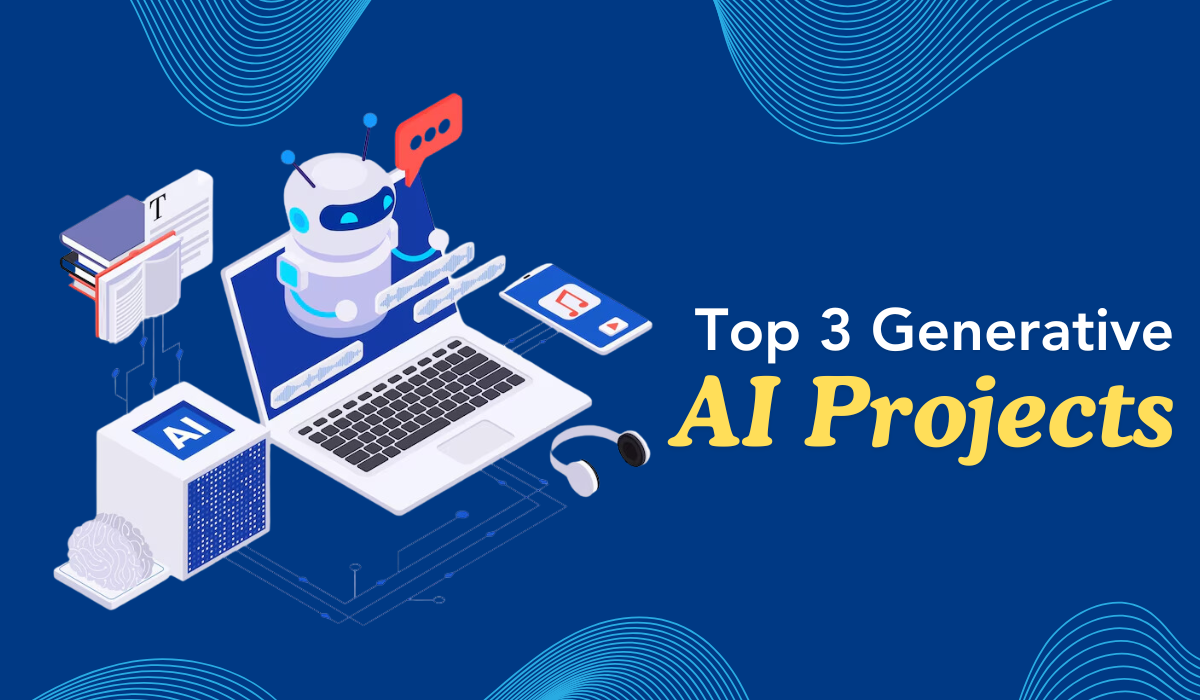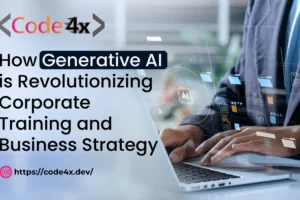
Top 3 Generative AI Projects for Hands-on Learning
Top 3 Generative AI Projects
Welcome to the exciting world of top 3 Generative AI Generative AI (GAI)! This field is revolutionizing how we create content, from realistic images to engaging music and even compelling narratives. As early career professionals, understanding Gen AI development offers immense potential for your future endeavors as we expect applications of tomorrow to be infused with Top 3 Generative AI Projects Gen AI features.
This blog focuses on project-based learning, a practical approach to mastering GAI concepts, especially RAG Application development. We’ll delve into three captivating projects that will equip you with the skills to explore the fascinating world of Large Language models (LLMs).
Here are three Gen AI, RAG development projects that would get you in a course to learn the concepts through hands-on.
Project 1 : Building a RAG Chatbot from Your Website Data using OpenAI and Langchain
Problem Statement: Building a chatbot for a website that can provide customer support 24/7 can be a challenging task. The chatbot needs to be able to understand customer queries, retrieve relevant information from the website, and provide accurate and helpful responses.
Solution Steps:
Step 1: Grabbing Valuable Content from Your Website
- Build a web crawler using Python’s requests library and Beautiful Soup to fetch text content from each webpage on the website.
- Clean the HTML content to extract relevant text and metadata.
Step 2: Cleaning Up the Raw Text
- Define cleaning functions to refine the raw text.
- Split the text into smaller, more manageable segments.
Step 3: Storing the Knowledge for Retrieval
- Use a vector store called Chroma to store the cleaned text snippets.
- Create a chain of functionalities to retrieve relevant information from the vector store using Langchain.
Step 4: Guiding the Conversation
- Craft an effective prompt for the Large Language Model (LLM) to guide the chatbot’s responses.
- Define the prompt structure in prompt.py to enhance the chatbot’s conversational style.
Step 5: Building the Brains of the Chatbot
- Leverage OpenAI’s large language models (LLMs) like GPT-3 to generate responses based on user queries.
- Connect the vector store, prompt, and LLM to create a Conversational Retrieval Chain for the chatbot.
Technologies Used: The project utilizes Python, requests library, Beautiful Soup, Langchain, OpenAI, Chroma vector store, and HTML2Text for building the RAG chatbot.
Learning Benefits:
By working on this project, learners will gain hands-on experience in building a custom chatbot trained on website data using advanced technologies like OpenAI and Langchain. They will learn how to extract, clean, store, and retrieve information from a website to create an intelligent conversational AI. Additionally, learners will improve their skills in web crawling, text processing, data organization, and integrating AI models for chatbot development.
Project 2 : Building a PDF Chat Bot with Retrieval Augmented Generation (RAG)
Problem Statement: In today’s digital age, there is a vast amount of information stored in PDF documents that can be challenging to navigate and extract relevant information from. The need for a chatbot that can interact with PDF documents and provide users with the necessary information in a conversational manner is evident. This project aims to address this issue by building a PDF chatbot using LangChain and OpenAI, allowing users to chat with documents and retrieve specific information efficiently.
Solution Steps:
- Extracting text from PDF documents: Utilize PyPDF2 library to extract text from uploaded PDF documents.
- Chunking or Segmentation of text: Break down extracted text into manageable chunks using CharacterTextSplitter from LangChain.
- Embedding the text and Ingestion in Vectorstore: Create embeddings of text chunks using OpenAI and store them in a FAISS vector store.
- Conversation using LLMs (OpenAI): Initiate a conversation with the chat model, retrieve information from the vector store, and generate responses using OpenAI.
Technologies Used: PyPDF2, LangChain, OpenAI, FAISS (Facebook AI Similarity Search)
Learning Benefits:
By working on this project, learners will gain hands-on experience with extracting text from PDF documents, chunking and embedding text for efficient processing, and utilizing chat models like OpenAI for conversational interactions. Additionally, learners will understand the importance of prompt engineering and how RAG-based systems operate, enhancing their knowledge of natural language processing and chatbot development.
Project 3 : Question-Answering with Chroma Vector DB x LangChain Integration
Problem Statement:
In the ever-evolving landscape of artificial intelligence, developers and businesses are constantly seeking more effective ways to utilize Large Language Models (LLMs) for question-answering systems. However, these advanced models like ChatGPT face limitations such as being unaware of updated knowledge post their last training cut-off and the inability to access proprietary or private company data. These challenges hinder the generation of accurate and up-to-date responses, especially in the business domain where tailored insights are crucial.
Solution Steps:
– Install LangChain and ChromaDB (Vector Database)
– Provide the OpenAI API key for knowledge retrieval
– Prepare the knowledge and embedding model using LangChain components
– Vectorize the knowledge documents with Chroma
– Create a RetrievalQA chain for question answering using the uploaded knowledge
Technologies Used:
– LangChain: Offers a unified interface and abstraction layer on top of LLM ecosystem components
– Chroma: A powerful vector database for efficient and semantic retrieval of information
– OpenAI: Provides embeddings for knowledge retrieval in question-answering systems
Learning Benefits:
By exploring the integration of Epsilla and LangChain in question-answering pipelines, learners can gain insights into the importance of combining LLMs with vector databases for more accurate and context-aware responses. This project not only showcases the technical implementation steps but also highlights the significance of leveraging advanced technologies to overcome the limitations of existing AI models. Learners can enhance their understanding of how to build generative AI applications effectively and deliver value to businesses in need of tailored insights.
Generative AI Projects for Beginners
Below table shows the Generative AI projects for beginners:
| Generative AI Projects for Beginners | |
| Generative AI Projects for Beginners | Description |
| 1. Text Generation with GPT-2 | Experiment with OpenAI’s GPT-2 model for generating diverse and coherent text based on prompts. |
| 2. Image Synthesis using DALL-E | Dive into image generation with OpenAI’s DALL-E, creating unique and imaginative visuals based on textual descriptions. |
| 3. Music Composition with Magenta | Explore Magenta, a project by Google, to generate music compositions using machine learning techniques. |
Conclusion:
As AI continues to reshape industries and drive innovation, understanding the potential of tools like LangChain and powerful Vector Databases databases will be essential for developers and businesses looking to stay ahead in the AI landscape. These projects serve as a valuable learning experience for learners seeking to explore the intersection of Generative AI – RAG Application development, knowledge retrieval, and question-answering systems.
#Top 3 Generative AI Projects #generativeaiprojects #Generative AI Projects for beginners #Generative AI Projects For Students



